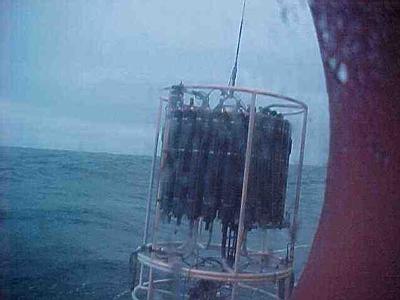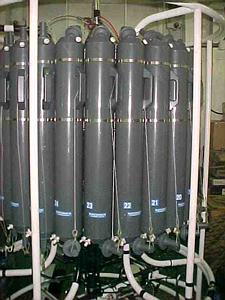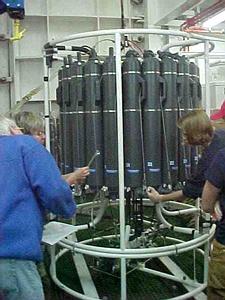15 November, 2000
Hello Everyone,
Last night a research group deployed the CTD (Conductivity Temperature
Depth) instrument. This device that they put in the water holds 24 Niskin
bottles (see picture below) and several other devices that read
temperature, density, salinity, depth and irradiance. The CTD can be
modified to record other data as needed. The Niskin bottles can be remotely
closed at various depths to collect water samples. It also send back
real-time data, like temperature, salinity, and depth to the Gould as it is
being lowered. As soon as the CTD is back on the ship, crews of researchers
descend upon the device to quickly collect samples. If they don't collect
their samples immediately then valuable data could be lost.
As soon as the others collected their samples Ray and I collected samples
from Niskin bottles 1, 11 and 12. Bottle one was collected at the deepest
depth, 200 meters or about two football fields in length. Bottle 11 was
collected at 10 meters depth and finally bottle one was collected at five
meters in depth. At 200 meters there should be very little phytoplankton
growing due to the lack of sunlight. So when we test the 200 meter sample
our chlorophyll samples should read zero or close to it. The other two
samples should give us a high values since they are close to the waters
surface. When we get to Palmer Station we will determine the exact amounts
of chlorophyll.
Tonight they will be deploying a second CTD and I was given permission to
watch the deployment from where the operator positions and deploys the CTD.
Once they bring it back on board again we will collect samples and
determine the amount of chlorophyll. There will also be a presentation by
the lead scientist on Cape Shireff. He will be discussing what they hope to
learn and what they have already discovered. Earlier today I was invited to
a briefing by a team of scientist who will be conducting their research on
Deception Island. I'll give you the details tomorrow.
So stay tuned for tomorrows action packed episode. It'll be a good one.
-- Bill

Deploying the CTD

Niskin bottles labeled from 1 -24.

Researchers collecting samples from the CTD.
Contact the TEA in the field at
.
If you cannot connect through your browser, copy the
TEA's e-mail address in the "To:" line of
your favorite e-mail package.
|
